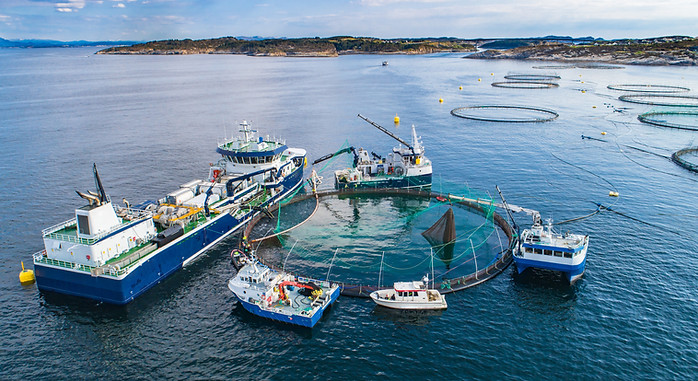Projects and Services
Counting the Cost of Sea Lice

Toxic algae blooms in lakes

Environmental Solutions Provider

The Cost of Sea Lice in Salmon Farming
The Cost of Sea Lice in Salmon Farming The salmon farming industry faces a persistent and costly threat: sea lice. These tiny parasites cause significant financial losses, environmental harm, and operational disruption. Here's a closer look at the challenge — and why it’s time for a smarter solution. Financial Burden Sea lice cost the global salmon industry billions every year. They reduce fish growth, compromise fish health, and increase mortality rates — all of which lead to substantial revenue loss and lower production efficiency. Environmental Consequences Conventional chemical treatments may help reduce lice levels, but they can also damage marine ecosystems and harm non-target species. These side effects weaken the industry’s sustainability efforts and reputation. Operational Strain Managing sea lice requires constant monitoring, repeated treatments, and strict biosecurity measures. This places significant pressure on daily operations, staffing, and long-term planning. A Smarter Path Forward At Water AS, we develop clean, efficient water treatment solutions that help reduce sea lice impact — without harming the environment or overburdening operations.

Tackling Blue-Green Algae: The Impact of Phosphate Pollution
Excessive phosphate pollution introduces high levels of nutrients into lakes and freshwater systems, triggering the rapid growth of blue-green algae (cyanobacteria). These algal blooms can pose serious environmental, economic, and public health risks. Toxin Production Some blue-green algae species produce potent toxins that are harmful to aquatic life, animals, and humans. These toxins can contaminate drinking water supplies and disrupt ecosystems. Oxygen Depletion When algae die and decompose, they consume large amounts of dissolved oxygen in the water. This process can create oxygen-depleted "dead zones," killing fish and other aquatic organisms. Environmental and Recreational Impact Algal blooms reduce water quality, making lakes unpleasant or even unsafe for recreational activities such as swimming, boating, and fishing. They also damage the visual and ecological value of natural water bodies. A Multifaceted Solution Successfully restoring a lake affected by blue-green algae requires an integrated approach: 1. Nutrient Management Reducing phosphate runoff through improved agricultural practices is a key first step. This includes better fertilizer application, buffer zones, and sustainable land use policies. 2. Water Treatment Targeted in-lake treatment methods such as chemical flocculation, aeration, and bioremediation can help remove excess nutrients and control algae levels. 3. Ecological Restoration Rebalancing the lake ecosystem may involve reintroducing native aquatic plants and fish species, improving habitat diversity and long-term resilience. 4. Monitoring and Regulation Continuous water quality monitoring combined with stricter regulation of agricultural runoff can help prevent future pollution events. 5. Public Awareness and Engagement Raising awareness of phosphate pollution and involving local communities in conservation efforts is essential for long-term protection and stewardship. Water AS: Research in Practice Water AS collaborates with researchers and academic institutions, including a partnership with the University of Stavanger, where students engage in applied studies based on Water AS’s lake restoration solutions.

Aquaculture: A Sustainable Solution for a Growing World
Fish farming is transforming the global food system by providing a scalable, reliable source of high-quality protein. As seafood demand continues to rise, aquaculture plays a key role in ensuring long-term food security. Sustainability at the Core By reducing pressure on wild fish stocks, conserving marine ecosystems, and lowering waste throughout the supply chain, aquaculture supports a more sustainable future for both people and the planet. Driven by Innovation The industry is evolving rapidly through technological innovation. New water treatment solutions, automated feeding systems, AI-based monitoring, and selective breeding are improving efficiency, health outcomes, and profitability. Global Reach, Local Impact Fish farms can be established in diverse environments – from coastal communities to inland facilities – creating jobs and supporting local economies. Through international trade, high-quality aquaculture products and solutions, including those from Water AS, are reaching markets worldwide. Continuous Development Through Research From land-based systems to compliance with increasingly strict environmental standards, research and innovation are driving the industry forward. Water quality is central to this progress, and ongoing improvements continue to unlock new potential. Water AS: Enabling Clean and Scalable Aquaculture At Water AS, we are proud to be part of the aquaculture revolution. Through advanced water treatment technologies and deep industry know-how, we help our partners build cleaner, more efficient, and more sustainable operations. We are committed to contributing to an industry that is not only commercially successful, but also essential to global food security and environmental resilience.


